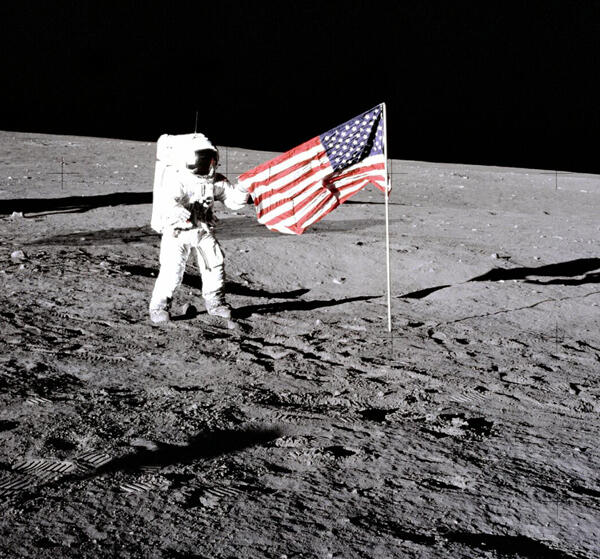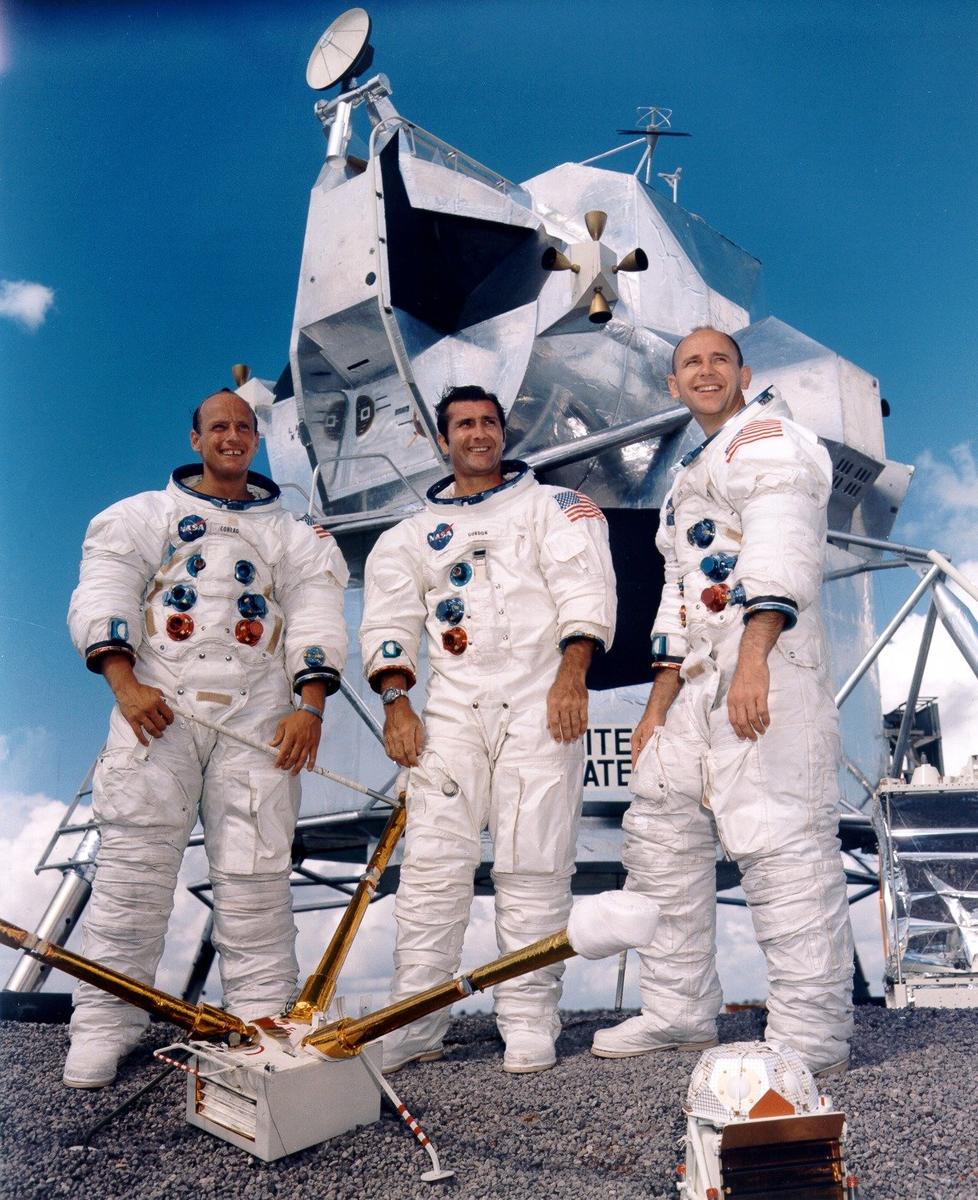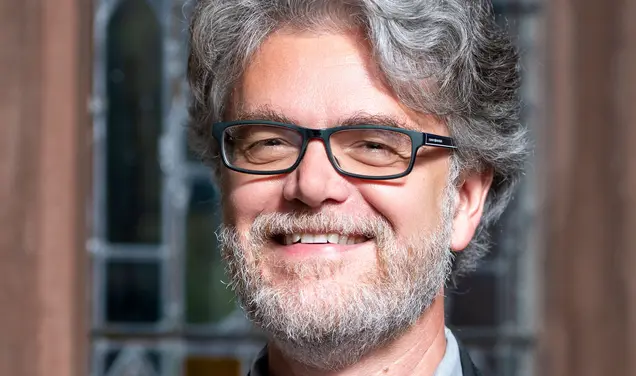On Nov. 19, 1969, Apollo 12 astronaut Charles "Pete" Conrad ’53 departed his landing craft and stepped onto the surface of the moon, becoming the third person — and the only Princetonian — to do so. His first words on the moon included an ecstatic tip of the cap to his more staid (and taller) colleague, Neil Armstrong. "Whoopee!" Conrad said, according to The New York Times. "Man, that may have been a small one for Neil but that's a long one for me."
The photo above shows Conrad planting the American flag during the moonwalk. He also carried the flag of his alma mater, and today, 40 years after that memorable stroll, that Princeton flag resides in the University Archives.
Conrad, who died in 1999 after sustaining injuries in a motorcycle accident, was a devoted aviator and engineering student as an undergraduate. After graduation, he became a Navy test pilot and later an astronaut trainee. He was known for his sense of humor, according to the profile below, which was first published shortly after Apollo 12's safe return.
Pete Conrad at Princeton
From PAW, Dec. 2, 1969
By Scott White ’73
Inside the cockpit of his Apollo 12 spacecraft 133,000 miles away from earth, Commander Charles ("Pete") Conrad Jr. ’53, twirled a small propeller atop his Navy braided cap in front of a fascinated television audience Nov. 15.
Symbolic of both his sense of humor and of his love of flying, the propellered cap is an apt adornment for Conrad on his voyage to the moon. From his undergraduate years at Princeton through his selection as one of nine astronaut trainees in September 1962 and continuing through this, his third manned space flight, Conrad has demonstrated extraordinary involvement and ability in flying.
During his junior and senior years at Princeton, Conrad worked in the Aeronautical Engineering program, became Vice-President of the Flying Club, and was a member of Colonial Club. One of his classmates in the Aeronautical Engineering program, Dr. K. Evan Gray of the Aeronautics and Research Association of Princeton, recalls Conrad's consuming interest in engineering and flying.
"He had an excellent practical feel for engineering," relates Gray. "Between the Navy ROTC program and engineering, his life was extremely full. Most of his free time was spent flying or, towards the end, with Jane." The future Mrs. Conrad was then a student at Bryn Mawr. They were married shortly after his graduation.
Though primarily fascinated with flight, Conrad also managed to charm many persons with his "outstanding personality," according to Mr. Thomas Sweeney, Senior Research Aeronautical Engineer, who was then a Research Assistant with Conrad. "He was not the kind one would call deeply serious, although he did spend a great deal of time working. He was a great mimic. His Donald Duck imitation was outstanding." Mr. Sweeney remembered Conrad as having "a great presence of mind and great ingenuity," and told of an incident he had once witnessed.
One day, Conrad and a friend came to visit him from the Patuxent River Base in Patuxent, Md., where he was a test pilot, in a T-28 airplane. The T-28 was an advanced training plane with a propeller clearance of less than a foot from the ground. The plane also had small, high-pressure tires designed for hard runways and aircraft carrier decks, not the grass fields which were used at Princeton.
Preparing to fly back to Patuxent after his visit, Conrad started up the engine. Instead of taxiing straight onto the field, however, he unknowingly veered left onto a septic system field. Because of its dampness, the high pressure tires sank and the three propellers ripped into the ground, striking a rock and damaging their tips.
Conrad had to bring the plane back that day, so he called over the head mechanic to survey the damage. They hack-sawed off the damaged part of one tip, filed it smooth, made a paper pattern of the propeller, and sawed each of the other two propellers down to the same size. The job finished, Conrad and his friend hopped into the plane and flew it back to Patuxent. 'This incident showed Pete's intuitive appreciation of the airplane's flexibility and his ingenuity," commented Mr. Sweeney.
Conrad's expert flying skill has also exemplified itself in other ways. Once, when he was practicing night flying, two of his friends suggested that a flight to Albany would give him good practice. Once they had begun the trip, however, the wind, which had been calm, turned blustery. By the time they reached Albany, Conrad skillfully landed the plane in what had become a gale. Nevertheless, after the group had eaten dinner, Conrad flew the plane back to Princeton. And with ease.
The 39-year-old astronaut apparently had always wanted to become a pilot. "As far as I know, Pete had always planned on being a naval aviator," commented Dean David C. Hazen, then an Assistant Professor and now Professor of Aeronautical Engineering. Sweeney remembered that Conrad was "completely dedicated to flying. He used to go out in the evenings after work, he was that serious about it."
When he wasn't in the air, he was frequently to be found in the research lab. During his undergraduate years, he helped design a wind tunnel. The wind tunnel had been promoted by Professor Daniel C. Sayre, first Chairman of the Department of Aeronautical Engineering and first Director of Forrestal Center, and is currently in use at Sayre Hall.
Between his junior and senior years, Conrad worked as a laboratory assistant, the profits from which paid for his flying. During his senior year, he participated in the preliminary design of an advanced jet trainer as part of his senior thesis.
After having received his Bachelor of Science of Engineering degree in 1953, Conrad entered the Navy and at-tended the Navy Test Pilot School at Patuxent River, Md. He also served as a flight instructor and per-formance engineer there. In flight training at Pensacola, Fla., Conrad received one of the highest marks in pilot proficiency given in many years.
Early in 1962, he applied for a position as an astronaut. Having fulfilled the requirements in age, height, degree, and proficiency, he was one of those selected out of a group of 250. In February 1965, he was chosen for the eight-day Gemini V mission, which surpassed the Russians' endurance record. Following that flight, he returned to Princeton and presented a banner which he had carried in the spacecraft.
President Goheen conferred an Honorary Master of Arts degree on Conrad in January 1966. In September of the same year, he commandeered the Gemini XI mission.
Aboard the Yankee Clipper, Conrad utilized his skills as a photographer and as a geologist, both of which he developed at Princeton. "He loved both aerial and trick photography," Sweeney reported. "He got one of the first inexpensive color movie cameras and took a lot of pictures when he was flying, he got some extremely good pictures from the air."
More than anything else, what should come across during Conrad's transmissions back to earth is his pleasant, humorous, and magnetic personality. Friends and colleagues consistently reported him as being "a great storyteller, a loyal friend, a real character," and "energetic." Returning for his class's 10th reunion, the native Philadelphian wrote in the Reunion Classbook: "When we graduated in 1953, people would have laughed out loud at anyone who said we would be flying in outer space or be planning a lunar landing in 1963."
Conrad, too, might have laughed had someone told him he was to be the third man in history to step onto the moon.













No responses yet